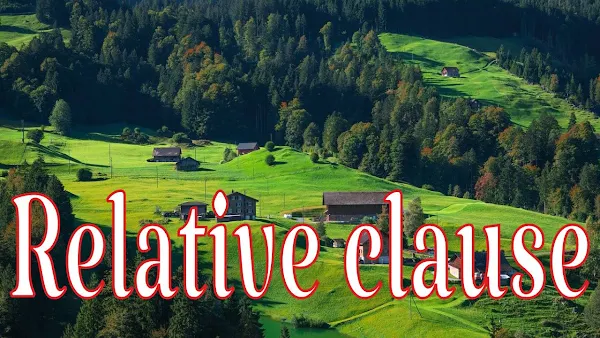A relative clause (sometimes it's called "adjective clause") adds extra information about one of the nouns in the main clause. It goes immediately after the noun it relates to. The relative pronoun goes at the beginning of the relative clause. The relative pronouns are WHO (WHOM, WHOSE), WHICH, at THAT. The relative pronoun can be omitted unless it is the subject of the relative clause.
1. The relative pronoun as subject of a relative clause
1.1. Relative clauses about people
WHO (or THAT*) links two separate ideas about the same person or people. We join these two ideas by using who instead of the personal pronoun HE, SHE, or THEY in the second clause. Let's see examples below:
(1) Simple clause: There's the doctor. He used to live next door.
(2) Relative clause: There's the doctor who* used to live next door.
- There's the doctor is a main clause.
- who used to live next door is a relative clause.
Ex: Sam spoke to Mrs Susan, who/
1.2. Relative clauses about things
WHICH or THAT** links two separate ideas about the same thing or things. We join these two ideas by using which or that instead of it or they. Let's see examples below:
(1) Simple clause: John's writing about a car. It doesn't work properly.
(2) Relative clause: John's writing about a car which doesn't work properly.
- John's writing about a car is a main clause.
- which doesn't work properly is a relative clause.
2. The relative pronoun as object of a relative clause
Let's see the relative pronoun that goes at the beginning of the relative clause even when it is the object of the clause.
2.1. Relative clauses about people
(1) Simple clause: There's the doctor. I met him yesterday.
(2) Relative clause: There's the doctor that/who/whom* I met yesterday.
2.2. Relative clauses about things
(1) Simple clause: John's writing about a car. He bought it for his father.
(2) Relative clause: John's writing about a car that/which** he bought for his father.
2.3. Omitting the relative pronoun
We often omit the relative pronoun when it is the object of the relative clause. However, don't omit it when it is the subject. In these examples, the brackets ( ) show where the pronoun is omitted.
(1) There's the doctor ( ) I met yesterday. (Compare 2.1. (1))
(2) John's writing about a car ( ) he bought for his father. (Compare 2.2. (2)
3. The position of the relative clause
A relative clause follows the NOUN it relates to, wherever the noun is in the sentence. Here the relative clause is part of the subject. This sentence is based on two ideas:
(1) The new phones have all been sold. (2) They were made in South Korea.
→ The new phones (that were made in South Korea) have all been sold.
* The clause in the bracket ( ... ) is a relative clause.
4. The functions of the relative clauses
Defining and non-defining* relative clauses have two functions.
4.1. Defining
The function of the defining relative clause is to give essential information in order to identify what / who you are talking about.
Ex: "The book has just been sold." "Which book are you talking about?" "The book (that) I showed you last month (has just been sold)."
* Defining clauses are sometimes called "restrictive", and non-defining clauses are sometimes called "non-restrictive".
4.2. Non-defining
The function of the non-defining relative clause is to give extra information, not essential for identifying what you are talking about.
Ex: I offered to let him stay at my house.
Adding another piece of information:
I offered to let her stay at my house, which is about fifteen minutes' walk from the town.
We usually separate non-defining clauses from the rest of the sentence. We do this by commas in writing and by separate intonation in speech.
5. Whose + clause
Whose is the possesive determiner form of who. It usually refers to a person or people. It replaces his, her, or their.
Ex:
Ex: The 50-year-old teacher, whose husband is Chinese, plans to visit Japan next year.
6. Preposition in relative clauses
We can place the preposition in front of the relative pronoun. But more often we place the preposition at the end.
Ex: This is the gun with which she was killed.
OR: This is the gun (which) she was killed with. (more formal)
When the preposition is at the end, we can use that instead of which, or we can omit the relative pronoun.
Ex:
(1) Sam is student that* I once shared a room with.
(2) The love he was waiting for never came.
This is the school that my sons go to.
But not:
This is the school
7. Sentence relative clauses
Sentence relative clauses refer back to the whole clause or sentence, not just to one noun. They always go at the end of the clause or sentence.
(1) James admires the President, which surprises me. (= "and this is surprises me")
(2) Tina never admits his mistakes, which is extremely annoying. (= "and this is extremely annoying"
7. Relative adverbs
When and where can be "relative adverbs"; they link a relative clause to the main clause by a connection of time or place.
(1) Do you remember the day (when) we first met? (defines which day)
(2) One day I'm going back to the town where I spent my childhood. (defines which town)
(1) Sam felt ill all the time (that/when) we were sharing a room.
(2) I've lost my purse. I'm going back to look for it in the place (that/where) I was sitting.
I hope this article helps. If you have any question, please leave a comment below.






No comments:
Post a Comment